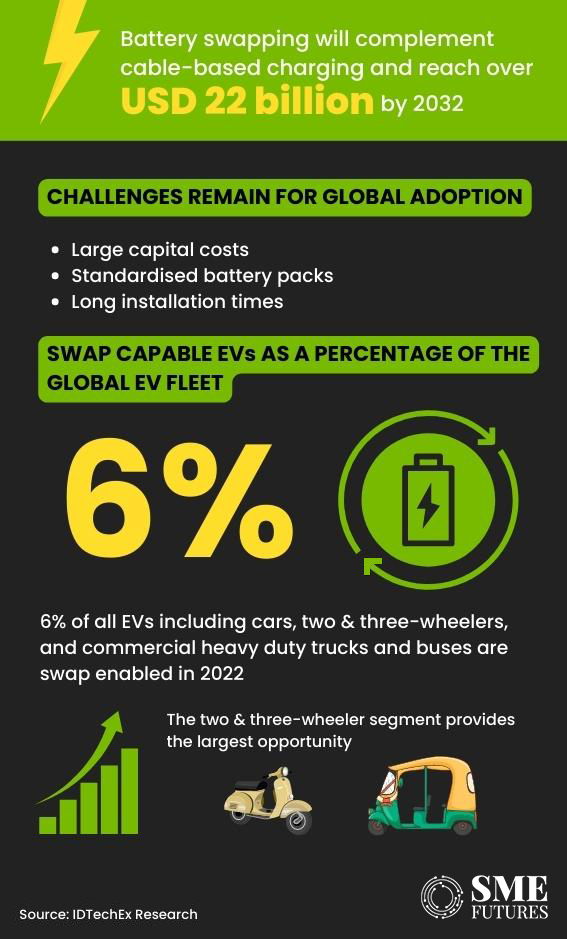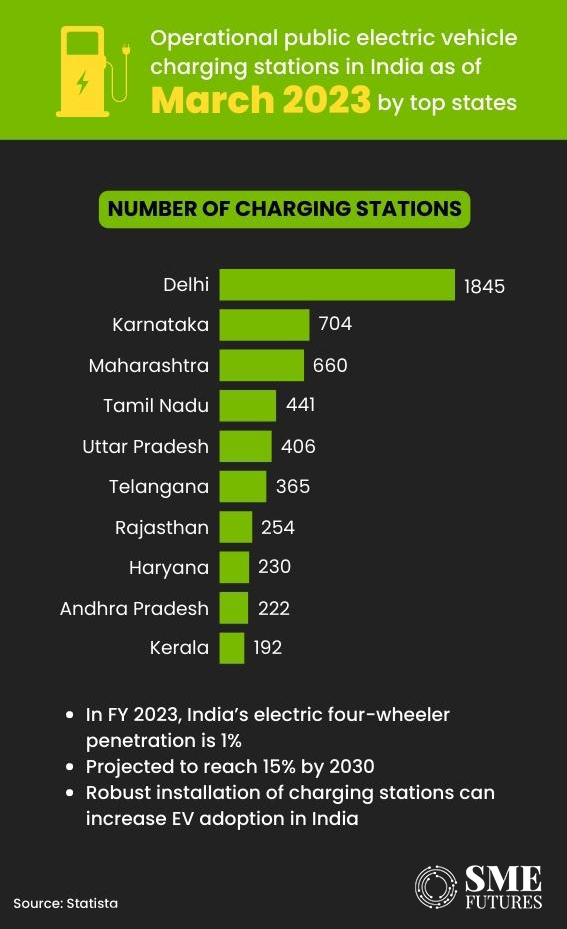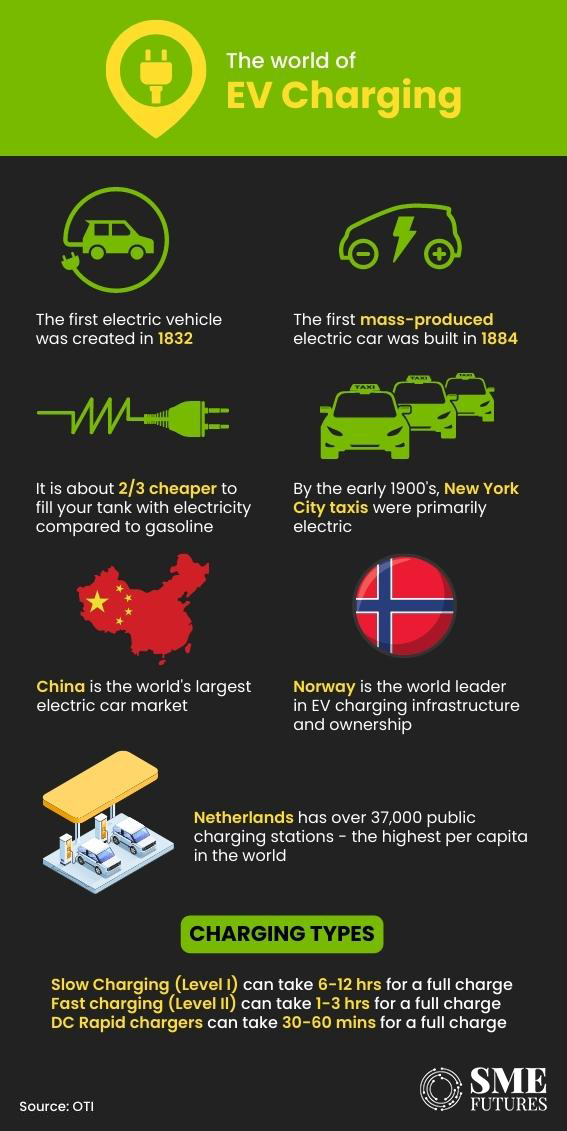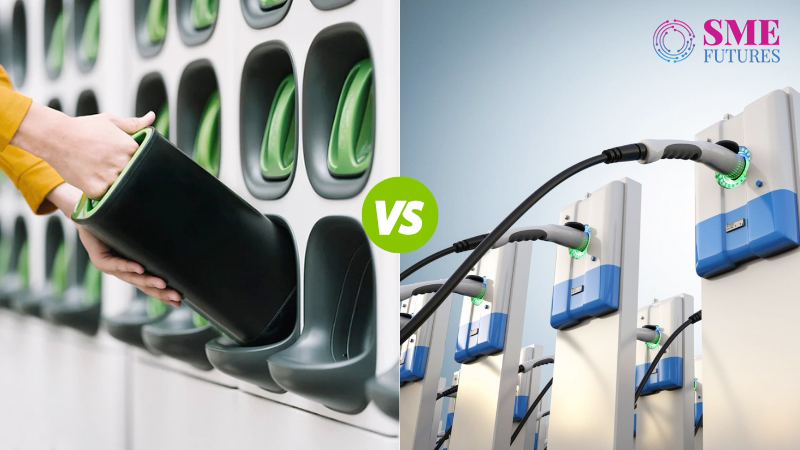The global EV revolution’s second decade finds India below par in the number of EVs on its roads. This brings us to a crucial problem – the time it takes to charge EVs. Choosing between the two charging solutions—EV charging stations and battery swapping, is not an either-or decision for India’s consumers.
The choice depends on the specific use case and the practicality of the vehicle, making it an essential economic consideration.
Nevertheless, the economic trade-off of EV infrastructure is not static but dynamic. It will keep changing as new battery chemistries are commercialised, and new EV power architectures hit the roads. The debate about which trade-off will prevail in the long run is still ongoing.
“The best charging solution for our country will be determined by a number of factors,” says Karthikeyan A- Co-Founder & VP of Embedded System Engineer at Raptee Energy.
Considering the country’s infrastructure, battery pricing, and EV driver’s preferences, EV charging stations are usually seen as the more cost-effective and sustainable option for the future.
Currently EV consumption is inorganic, majorly being pushed by incentives. But there are environmental benefits involved in choosing EVs over conventional fuel vehicles, that’s why EVs are predicted to take over in the coming years. But what’s the best way to charge them?
Battery swapping is the trend!
In battery swapping, users replace spent EV batteries with fully charged ones, eliminating the need for long charging periods.
“Battery swapping in e-mobility is a fast-growing trend and is of particular use in specific applications of e-mobility,” says Hasan Ali, Co-Founder at Esmito.
Majorly, e-rickshaws and commercial two-wheelers have been the two common use cases for swapping. Both these cases demand high daily runs in terms of kilometres travelled and in both cases the vehicle is used to earn a livelihood.
“If we look at global trends, developing economies with a higher proportion of two and three wheelers hold a lot of promise for battery swapping because these are densely populated, price sensitive markets,” he adds.
Swapping is already gaining ground in Taiwan, Southeast Asia, Africa, and South America. Apart from India, all these markets show clear indications of battery swapping adoption in the commercial segment for 2 and 3 wheelers.

EV charging stations are better for the long run!
Manjula Girish, Head-EV Charging and Photovoltaic Inverter Division, Delta Electronics India, firmly believes that EV charging stations are the future of EV charging in India.
“As the EV market expands rapidly, they provide a scalable and sustainable solution. Setting up charging infrastructure in several locations efficiently responds to the growing number of EV users, offering convenient and accessible charging alternatives, and encouraging future adoption,” she contends.
“Secondly, EV charging stations complement India’s changing energy landscape by incorporating renewable energy sources. Integrating EV charging with renewable energy produces a cleaner and greener charging ecosystem, lowering electric vehicles’ carbon footprints. Furthermore, charging stations give EV users flexibility and convenience by allowing them to charge their vehicles at home, at work, or in public places, improving the overall user experience and minimising range anxiety,” she adds.
Awadesh Kumar Jha, Executive Director of Glida (erstwhile Fortum Charge & Drive India) says that EV charging stations are not going anywhere.
Jha uses the example of replaceable phone batteries to demonstrate that though they were widely used once, we have smartphones now that can be charged anytime.
“The same is true for EV charging stations. They are a cost-effective and practical alternative for consumers who have invested heavily in EVs. Furthermore, Indians are possessive of their investments. So, if you are buying a car and are unsure about the battery, you will think that it might cause you some problems while driving. These psychological factors will never allow battery swapping in cars to be successful,” he says.

Co-existence is the key
While there is a debate over which charging system will be the future of EV charging in India, there is a third argument. Can the two systems co-exist?
Battery swapping player Esmito’s Co-Founder Hasan Ali advocates for the idea. He believes that both battery swapping and EV charging stations can co-exist in India.
“Almost 35 per cent of our 2W vehicles and 100 per cent of our 3W vehicles are being used for commercial purposes where battery swapping is an inevitability. Commercial applications demand long hauls, and the daily run requirement is between 70 to 120 Kms on an average. This means a daily charger requirement of at least 2-3 hours. This makes swapping inevitable in commercial use cases. While in personal usage the daily run is less than 40 Kms on average, making fixed charging or night charging a useful option. That means EV charging stations are going to be there,” he comments.
Charging stations VS battery swapping, a comparison
EV charging stations or battery swapping depends upon the specific needs of consumers. The type of EV they are driving is one of them. There are pros and cons of each charging solution.
Karthikeyan A says, “Building and maintaining a network of charging stations is often more cost-effective, requires less initial investment and is more scalable than establishing a large battery-swapping infrastructure. While battery swapping stations necessitate a larger upfront investment in specialised infrastructure and logistics, making them more difficult to execute on a broad scale.”
He further adds that battery health and ownership wise, there are concerns about the quality and condition of the batteries being swapped. Different battery packs may degrade at different rates, affecting the vehicle’s overall performance and range. Charging stations allow vehicle owners to maintain control over their battery’s health and usage, assuring optimal performance throughout the battery’s lifespan.
Also, with evolving battery tech, the range of EVs is increasing, reducing the need for frequent charging. “This improvement diminishes the perceived advantage of battery swapping, which is often promoted as a quick solution for limited range EVs. As batteries become more energy-dense and charging times decrease, charging stations will become more efficient and comparable in terms of convenience,” he says.
Building infrastructure needs swift solutions
Industry experts advocating for charging stations feel that the availability of adequate charging points and fast charging options need to be ensured.
Girish says, “Strategic planning and incentives can encourage businesses to invest in charging station set-ups, promoting widespread accessibility. Interoperability and standardisation of charging protocols are vital for seamless and user-friendly experiences.
Karthikeyan A says that as the number of EVs grows, charging stations must be able to handle the increased load on the electrical grid. “This necessitates grid infrastructure upgrades as well as the adoption of smart charging solutions capable of optimising charging periods depending on electricity demand and supply patterns,” he asserts.
Also, encouraging the integration of charging infrastructure with renewable energy sources can enhance the sustainability of EVs. Incentives for installing solar panels at charging stations or using renewable energy credits can promote clean energy usage in the charging process.
To overcome various challenges and expedite the growth of EV charging stations, a multi-pronged approach is essential.
“Collaborations between public and private entities can help secure prime locations for charging stations, enhancing convenience for EV owners. Furthermore, the integration of renewable energy sources into charging infrastructure will enhance sustainability and contribute to a greener energy ecosystem,” says Girish.
Talking about the challenges of battery swapping, Ali of Esmito agrees that swapping is a capex affair. “We need extra/ float batteries to keep the system running and we need swap stations to run the swaps. The infrastructure is hard to build for any one company and also has integration challenges with vehicle OEMs,” he says.
A better way to solve this problem is through the Platform as a Service Model where the solution is sold upfront to franchise partners and service is provided through the software platform. “The distributed ownership of swap stations and swappable batteries will enable its large-scale propagation but will need standardization of form factor and a communication protocol,” Ali says.
The standardisation challenge is being tackled in a “Demand Backwards” fashion. Most energy operators operate with a limited number of commercial participants, making standardisation a challenge that can be solved on a small, local scale. Also, as the business develops and matures, the number of form factor variations will surely reduce, making this a smaller difficulty to overcome as time passes.

What policy tweaks can do
To accelerate EV infra, institutions have been working on various policies. But according to experts, these policies could do better if certain amendments were to be made to them.
According to Karthikeyan A, streamlining permit processes and lowering regulatory barriers to charging station installations can help to accelerate infrastructure growth. Policies including simplified permit processes, tax breaks, and land-use rules can encourage rapid deployment.
Girish recommends implementing time-of-use tariffs for electricity consumption to encourage EV owners to charge their vehicles during off-peak hours, optimising grid management and reducing peak-hour stress.
“Additionally, setting clear emission standards and promoting EV adoption in government fleets will bolster the growth of EV charging infrastructure. This will instil consumer confidence in EVs and spur the demand for more charging stations,” he says.
By enacting these policy tweaks and taxation reforms, India can nurture the arena of EV charging, making it a sustainable and viable option for all stakeholders. These measures will not only encourage investments in charging infrastructure but will also drive EV adoption, ultimately contributing to a greener and more energy-efficient transportation landscape in the country.
Meanwhile, to promote battery swapping, the government has already begun the process of the drafting of its battery swapping policy. However, the policy is in silo due to stakeholder concerns.
“The policy is yet to see the light of day. Also, the tax on individual batteries is still 18 per cent as compared to the tax on the entire vehicle which is 5 per cent. This inequity in tax structure needs to be addressed. These two important changes can go a long way in mainstreaming battery swapping in the country,” says Ali.











